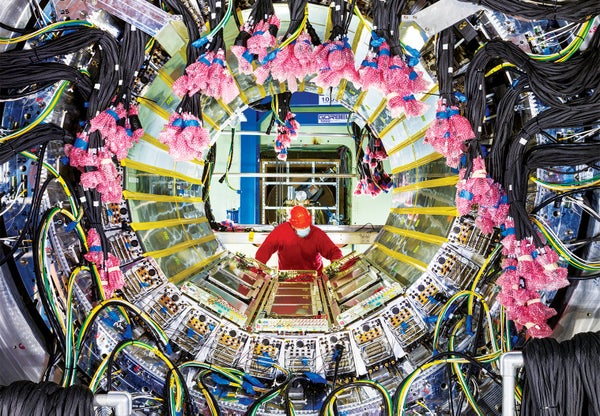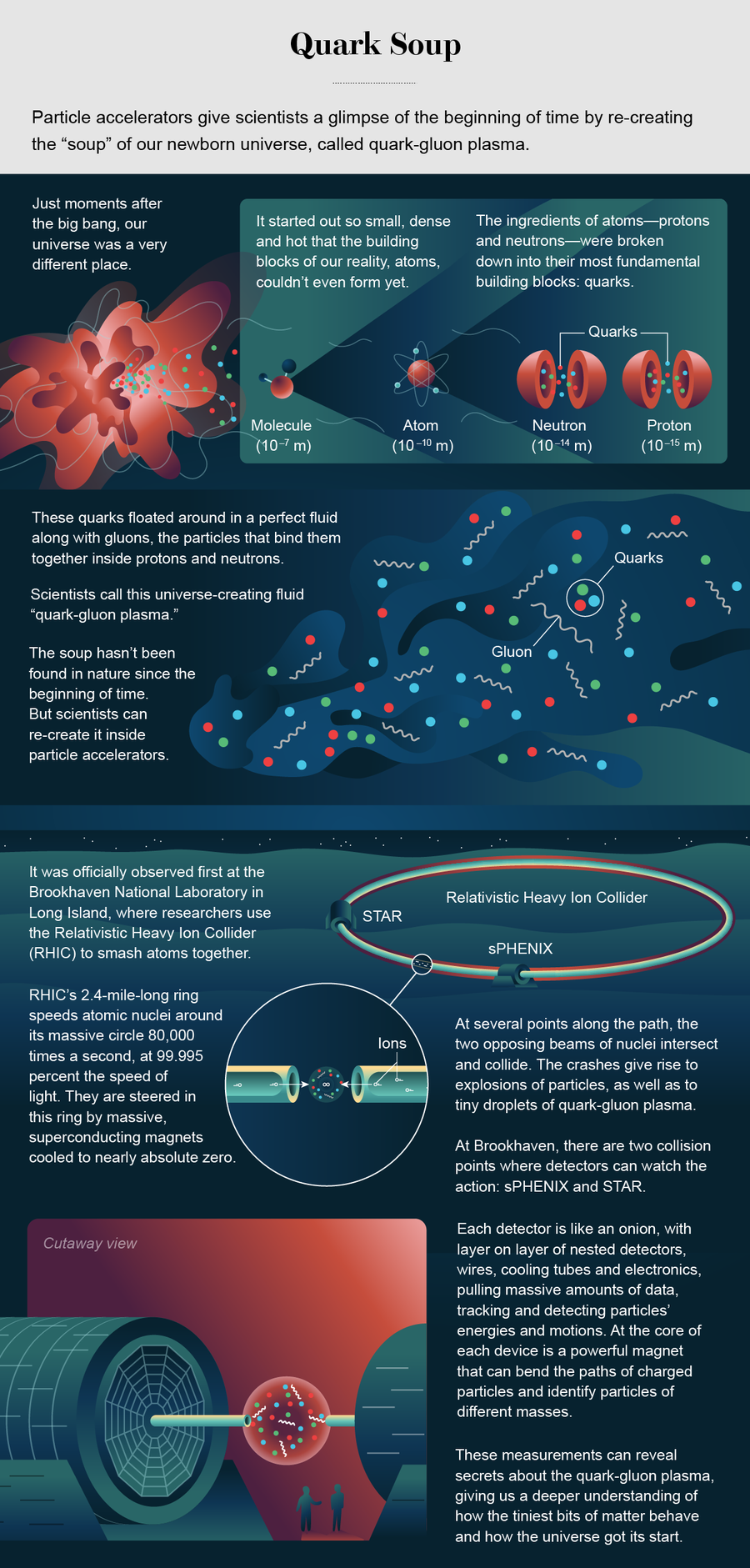Imagine you have a microscope that would let you see a single atom up close. Let's say it's a hydrogen atom, the smallest kind. Zoom in past the single electron orbiting at the outskirts, and you'll find the nucleus—in this case a lone proton. High school physics would have you believe that inside this proton you'll find a simple triad of three fundamental particles called quarks—two up quarks and one down quark. But the reality inside a proton is so much more complex that physicists are still trying to figure out its inner structure and how its constituents combine to produce its mass, spin and other properties.
The three quarks in the basic picture of the interior of a proton are merely the “valence quarks”—buoys bobbing on top of a roiling sea of quarks and antiquarks (their antimatter counterparts), as well as the sticky “gluon” particles that hold them together. The total number of quarks and gluons inside a proton is always changing. Quark-antiquark pairs are constantly popping in and out of existence, and gluons tend to split and multiply, especially when a proton gains speed. It's basically pure chaos. The strong force—the most powerful of the four fundamental forces of nature—keeps this mess confined to the insides of protons and neutrons. Except when it doesn't.
In the first tiny fractions of a second after the big bang, the universe was too hot and dense for the strong force to bind quarks and gluons together. Instead they became an ocean—a perfect liquid of particles flowing with almost no resistance, called a quark-gluon plasma. This stage of the universe's history ended quickly. Within 10-6 second, quarks and gluons were caged inside protons and neutrons. But then, 13.7 billion years later, physicists learned how to re-create the quark-gluon plasma inside particle accelerators. When two large atomic nuclei (such as gold) smash together at nearly the speed of light, the collision produces the temperatures and pressures needed for droplets of quark-gluon plasma to form, briefly, before disintegrating.
The machines that capture these collisions are towering constructions, stacks of detectors and instruments arranged in concentric rings, all of it connected with thousands of wires. When I visited two of them last year at the Brookhaven National Laboratory's Long Island campus, I marveled at the painstaking work of large teams of technicians climbing multiple levels of scaffolding to access the devices. Standing underneath such a colossus feels like witnessing the pinnacle of what humans can achieve—these are some of the largest and most intricate machines ever built, all to study a drop of primordial ooze even smaller than an atom. Investigating droplets of quark-gluon plasma gives scientists a chance to learn how matter got its start. “This is what filled the entire universe about 10 microseconds after the big bang,” says Bjoern Schenke, a Brookhaven theoretical physicist. “Studying it allows us to go back in time as much as we possibly can.”
The research is also a window into the strong force, the least understood of all nature's forces. This force is described by a theory called quantum chromodynamics (QCD), which is so complicated that scientists can almost never use it to calculate anything directly. The best they can do is to use supercomputers running simulations to get approximate answers. “As human beings, we want to understand nature, and part of understanding nature is to understand quantum chromodynamics and the strong force,” says physicist Haiyan Gao, associate laboratory director for nuclear and particle physics at Brookhaven. “We need to do experiments on quark-gluon plasma to understand how this theory works.”
In April 2023 Brookhaven scientists will turn on the latest experiment designed to study quark-gluon plasma. The device, called sPHENIX, is one of two detectors at the lab's Relativistic Heavy Ion Collider (RHIC), one of the largest particle accelerators in the world. The other detector there, the Solenoidal Tracker at RHIC (STAR), is also reopening after major upgrades. Across the Atlantic at the European CERN physics lab near Geneva, the globe's biggest accelerator, the Large Hadron Collider (LHC), recently began a new run with upgraded detectors and an ability to smash many more atoms at once. Together these tools should reveal the most detailed picture yet of this primordial fluid, bringing us closer to unraveling the secrets of the tiniest constituents of matter.
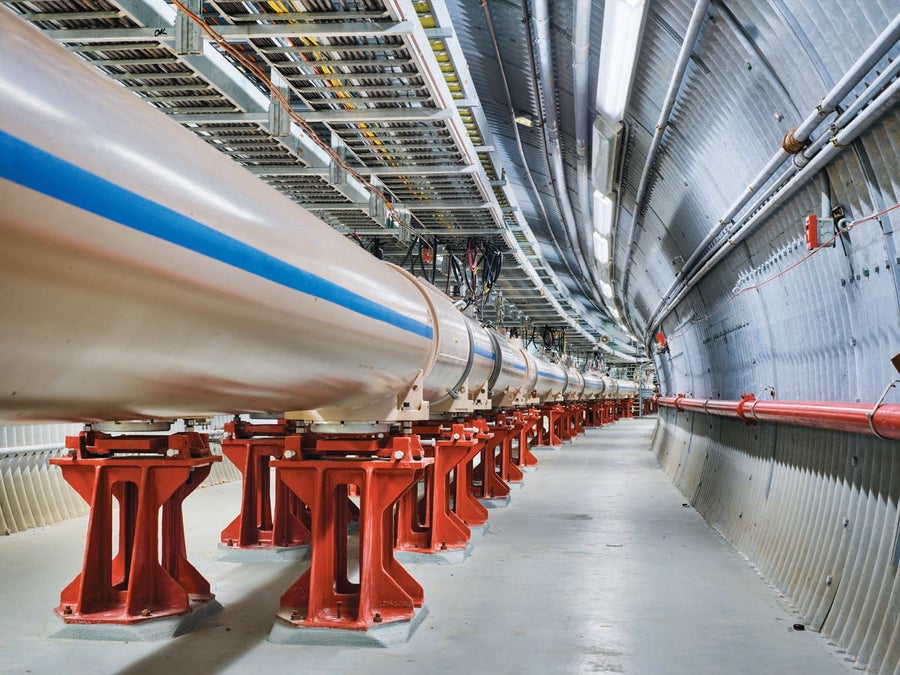
A Surprising Discovery
Scientists predicted quark-gluon plasma long before they discovered it—although they expected it to take a very different form. The predictions came about in the 1970s and 1980s, following the discovery of quarks in the late 1960s and of gluons in 1979. Physicists expected that quarks and gluons, when freed from nuclei, would take the form of a uniformly expanding gaseous substance. “Usually fluids turn to gas as they get hotter,” says Berndt Mueller, a physicist at Duke University, who started working on theoretical models for quark-gluon plasma in the 1980s. It was a reasonable assumption: quarks and gluons aren't released from nuclei until they reach temperatures of trillions of degrees.
Mueller was attracted to the field because the theoretical possibilities were wide open, and experimental data were set to start arriving soon. “At that time I was about 30 years old, and you look around for new things you could work on where you have lots of interesting stuff to discover.” During this era physicists were developing technologies to smash together heavy ions—nuclei with dozens of protons and neutrons inside them—and they expected these collisions to generate temperatures and densities that would break subatomic particles apart. The earliest heavy ion collisions, which took place in the 1970s at Lawrence Berkeley National Laboratory, weren't powerful enough to create quark-gluon plasma, but in 1986 the Super Proton Synchrotron (SPS) accelerator at CERN began its own heavy ion collisions, and those produced the first evidence for the new state of matter.
It took a while. The CERN team eventually announced their findings in 2000, but even then researchers were divided over whether the data were strong enough to claim a discovery. That same year Brookhaven's RHIC opened and started crashing heavy ions at higher energies than at the SPS. Within five years this accelerator had amassed enough data that physicists declared quark-gluon plasma officially found.
It wasn't what they had imagined. Instead of an expanding gas, the quark-gluon plasma looked like a liquid—a nearly perfect one, with almost no viscosity. In a gas, particles act individually; in a liquid, particles move cohesively. The stronger the interactions among particles—the more they can pull one another along—the “better” the liquid is at being a liquid. The RHIC observations showed that quark-gluon plasma exhibited less resistance to flow than any substance ever known. This, Mueller says, “was very much unexpected.”
In 2010 RHIC researchers announced the first measurement of the quark-gluon plasma's temperature. It was a scorching four trillion degrees Celsius, far hotter than any other matter ever created by humans, and about 250,000 times hotter than the middle of the sun. “Usually the hotter something becomes, the less of a perfect fluid it becomes,” Mueller says. “But in this case, it's the opposite—when you reach the critical temperature, it turns into a liquid.” Scientists suspect the strong force is behind this odd behavior. When the particles become hot enough to escape from protons and neutrons, the strong force acts over the entire plasma, causing the collective mass of particles to interact strongly with one another.
The Mystery of the Strong Force
One of the biggest open questions about quark-gluon plasma is when, exactly, the quarks and gluons break out of their confinement. “Where is the boundary between usual matter and quark-gluon plasma?” Gao asks. “Where is the so-called critical point where the nuclear matter and the quark-gluon plasma coexist?” Understanding where that transition happens, and how many particles it takes to initiate the collective behavior, will be among the main goals of the new and upgraded experiments.
Another question is whether quark-gluon plasma is a fractal—that is, whether its structure has a complex, repeating pattern that appears the same at every scale, whether you zoom out or in. Some researchers have been arguing that quark-gluon plasma has these two properties and that fractal theory could offer insights into how the plasma behaves. “There is evidence that we have fractal structure in quark-gluon plasma,” says Airton Deppman, a physicist at the University of São Paulo's Institute of Physics. “We are also investigating if the fractal structure survives the phase transition” from plasma to proton.
Answering these questions could help with a larger goal: understanding the strong force, the most confusing of nature's fundamental forces. Quantum chromodynamics describes the interactions between quarks and gluons by ascribing them a property called color charge. This color charge is akin to electrical charge in the theory of electromagnetism, and it also explains why quantum chromodynamics so quickly gets out of hand. Whereas electromagnetism has only two charges—positive or negative—QCD has three—red, green or blue. And antimatter particles can carry antired, antigreen or antiblue charge.
In electromagnetism, the particle that carries the electromagnetic force, the photon, is itself electrically neutral, which keeps things somewhat simple. In QCD, though, the force carrier, the gluon, also carries a color charge and can interact through the strong force with itself and with quarks. These self-interactions and extra charges have made QCD prohibitively complicated. “You can write down the theory essentially in two lines, but actually solving it has not been really achieved,” Schenke says. “The process of confinement—how gluons and quarks are being trapped in the proton, for example—has not been solved.”
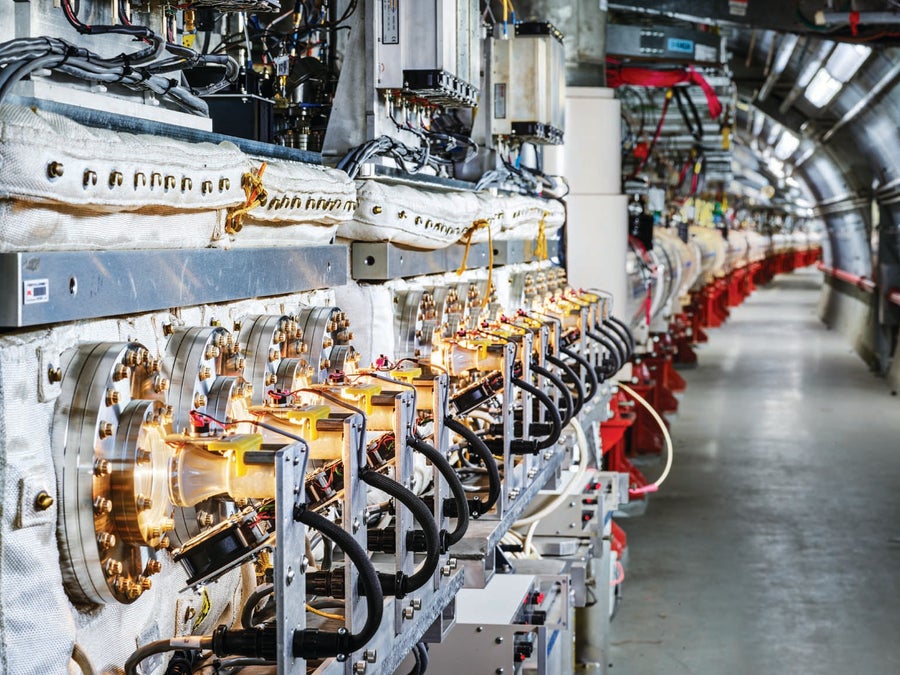
Scientists hope that studying quark-gluon plasma—the only situation in which scientists have ever been able to probe unbound quarks—could reveal more about how confinement works. “One way to get at that is to free them and see how they then recombine again to protons, neutrons and other particles that we can observe from the detector,” Schenke adds. Thus, experimental data from heavy-ion collisions can be used to better understand the mechanisms within QCD that lead to confinement.
New and Improved
With the RHIC's new experiment, sPHENIX, and the upgraded STAR detector, scientists should be able to take the most precise measurements of the plasma yet. For instance, sPHENIX has a superconducting magnet that is roughly three times stronger than STAR's. “That's important for many of the things we want to measure,” says David Morrison, a Brookhaven physicist working on the new machine. “If you have a collision, particles come out every which way, and then the magnetic fields bend their paths. We can look at that to start unraveling what kind of particle was it and how much energy and momentum did it have?” The team is hoping to spot composite particles called upsilons, for example. Upsilons, which contain a bottom quark and an anti-bottom quark, can form in collisions and then fly through the quark-gluon plasma, acting as test probes to reveal how the plasma changes them. “We can really unravel the physics that underlies a lot of the weird properties of the quark-gluon plasma,” he adds.
The experiment will also benefit from being able to record much more data—meaning many more collisions and the particles they result in—than was possible before. STAR captures around 10 petabytes of data a year; sPHENIX will take around 150 petabytes annually. That increase will bring previously unanswerable questions within reach.
STAR also has novel capabilities, such as new calorimeters for measuring the energies of particles and tracking detectors for identifying particles with different electrical charges. Among the most significant additions, says Brookhaven's Lijuan Ruan, one of STAR's spokespeople, are “forward” detectors that can record particles flying out of collisions at wider angles than before, including particles moving in the same direction as the beams that fed into the crash. “Now that's basically it—we're not going to upgrade anymore,” says Ruan, who has been working on STAR for many years and helped to build some of its early components around 20 years ago as a graduate student. “It's a different feeling when you just use a detector, compared to when you actually build it and the entire collaboration can use it,” she says. “I feel proud.” STAR, which was among the original RHIC experiments that helped to discover quark-gluon plasma, will operate for another three years before shutting down.
In Europe, the LHC recently began its third run, which started in July 2022 and will continue until 2025. After the latest upgrades, LHC scientists can analyze about 100 times more lead-lead collisions than they could during the first two runs. The extra collisions will also increase the precision of measurements. “One of the important goals for run three is to precisely quantify the properties of the quark-gluon plasma and connect them to the dynamics of its constituents,” says Luciano Musa, a member of the ALICE experiment at the LHC.
Compared with the RHIC experiments, the LHC collisions occur at higher energies and produce a hotter, denser and longer-lived quark-gluon plasma. These energetic smashups also create a larger variety of particles that scientists can use to probe the plasma's properties. “The studies at RHIC and LHC really go hand in hand,” Musa says. “Studying the properties of relativistic nuclear collisions at different energy scales and with different collision systems at CERN and RHIC allows us to gain a more profound and comprehensive understanding of nuclear matter.”
The different energy ranges reveal different aspects of the plasma. Raghav Kunnawalkam Elayavalli, a physicist at Vanderbilt University, did their Ph.D. work at the LHC, but recently became a member of the STAR and sPHENIX collaborations to focus on the particles coming out of lower-energy collisions. “They are closer to the scale of the plasma; they talk to it a lot more,” Kunnawalkam Elayavalli says. “Think of it like a party: there's a lot of people, and you're making a beeline to the exit. But if you're kind of slow and you don't want to leave that fast, you get a chance to talk to people on your way out.” Because particles flying through the quark-gluon plasma at RHIC take longer to move through it, they can extract more information from it. “The things we're trying to measure are the transport properties—the average distance you can go without interacting with another particle,” they add. “It tells us about the fundamental scale of the plasma.”
Back to the Beginning
The new era of quark-gluon plasma experiments should move the field beyond the basics and toward concrete answers to long-standing questions. “There was a period of physics at RHIC that was basically, ‘Wow, this happening—this is new physics,’” Kunnawalkam Elayavalli says. “And now we are in the precision era. We can ask, ‘Why is this happening?’”
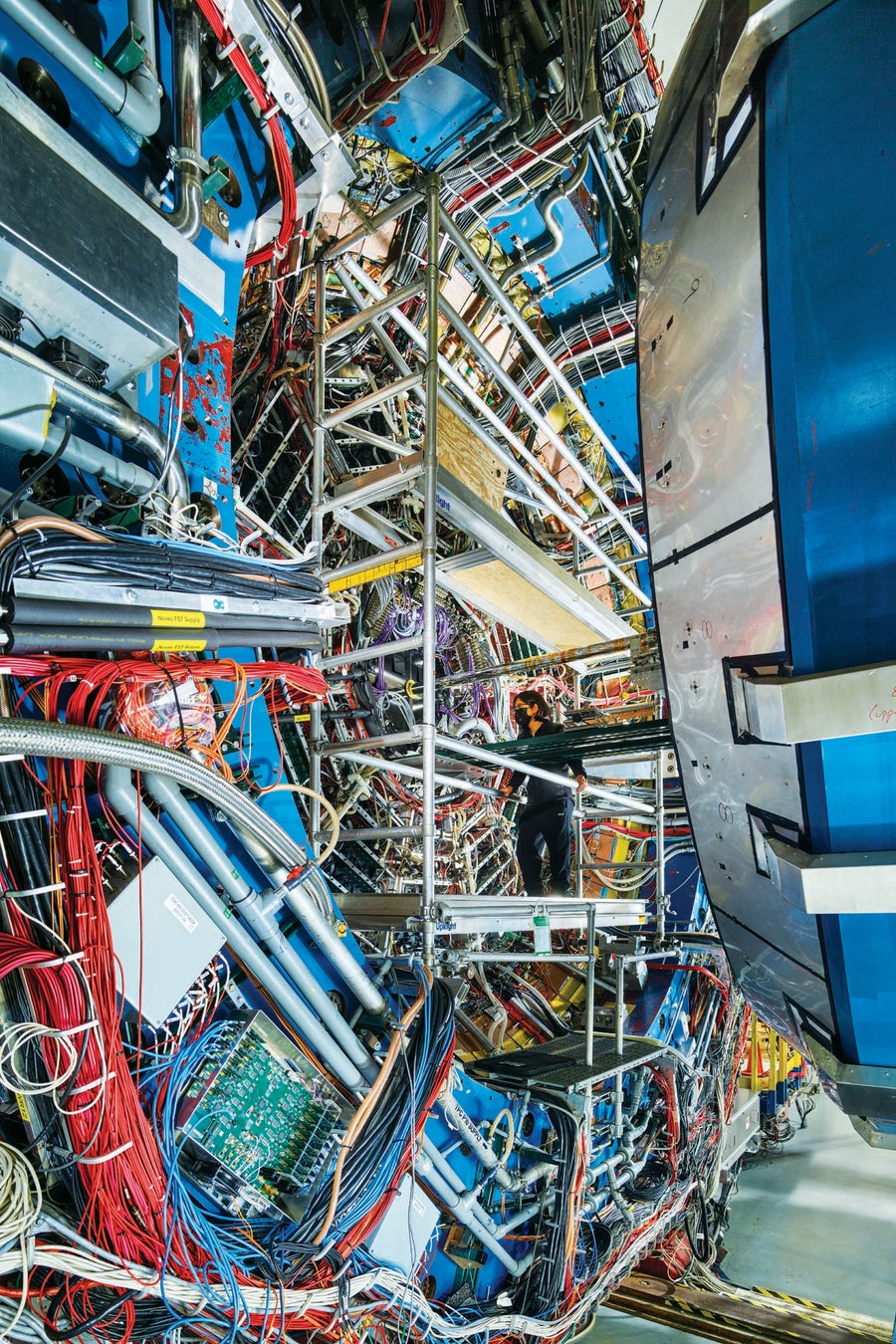
RHIC and the LHC are leading the effort to understand this special state of matter, but upcoming experiments elsewhere will also add insights. At CERN, alongside the LHC, the SPS accelerator is still running. A planned experiment there called NA61/SHINE will collide moving ions into a stationary target to measure the critical point when protons and neutrons turn into quark-gluon plasma. A second fixed-target experiment, the Facility for Antiproton and Ion Research (FAIR) at GSI Darmstadt in Germany, is due to open in 2028. And at the Joint Institute for Nuclear Research in Dubna near Moscow, a collider called the Nuclotron-based Ion Collider fAcility (NICA) will also probe the critical point.
“It's an exciting time,” Mueller says. “We know the quark-gluon plasma existed in the early universe, but we have no way of probing that. This is our way of probing a physics situation that otherwise we don't have any hope to reach.”
